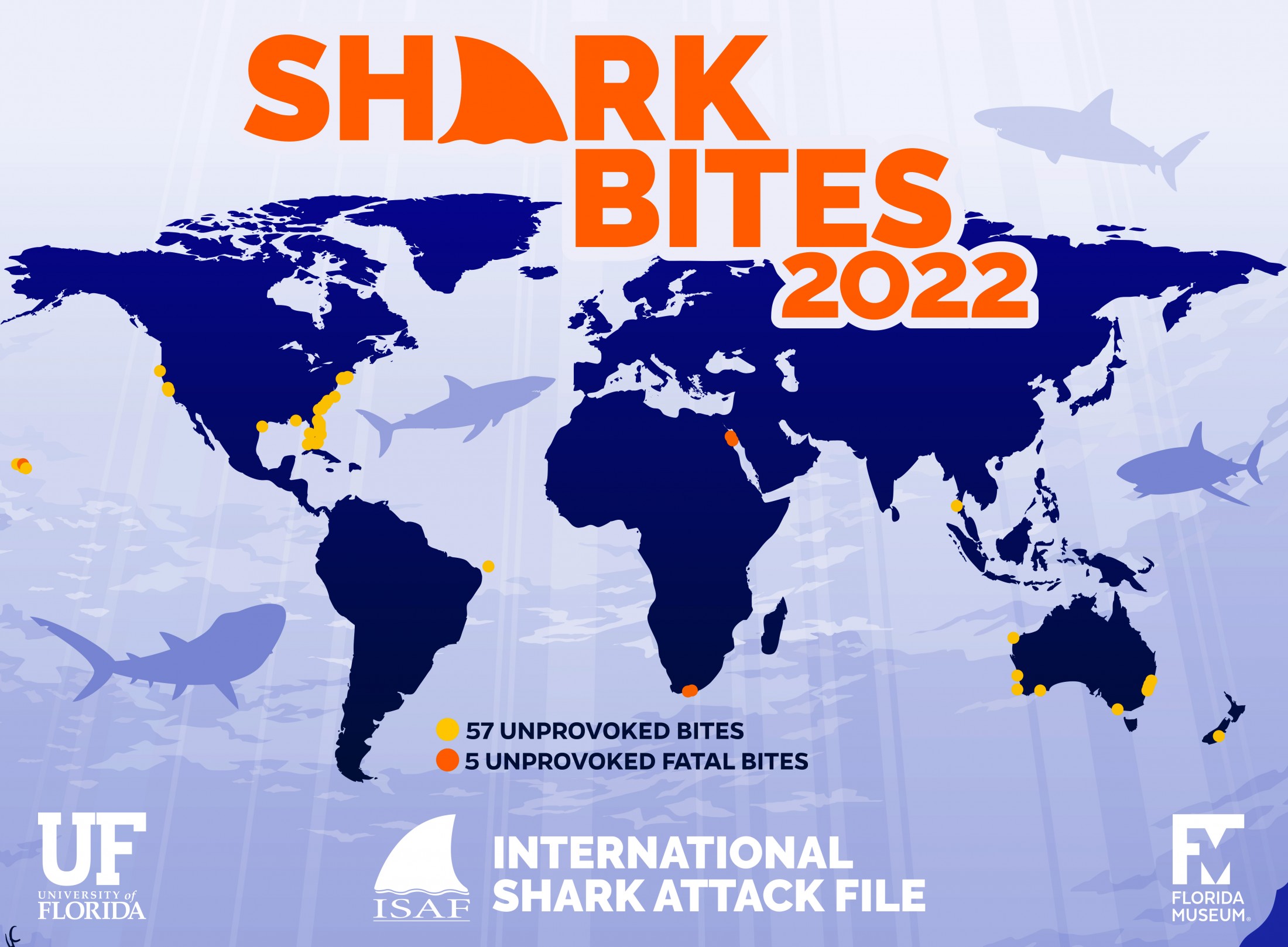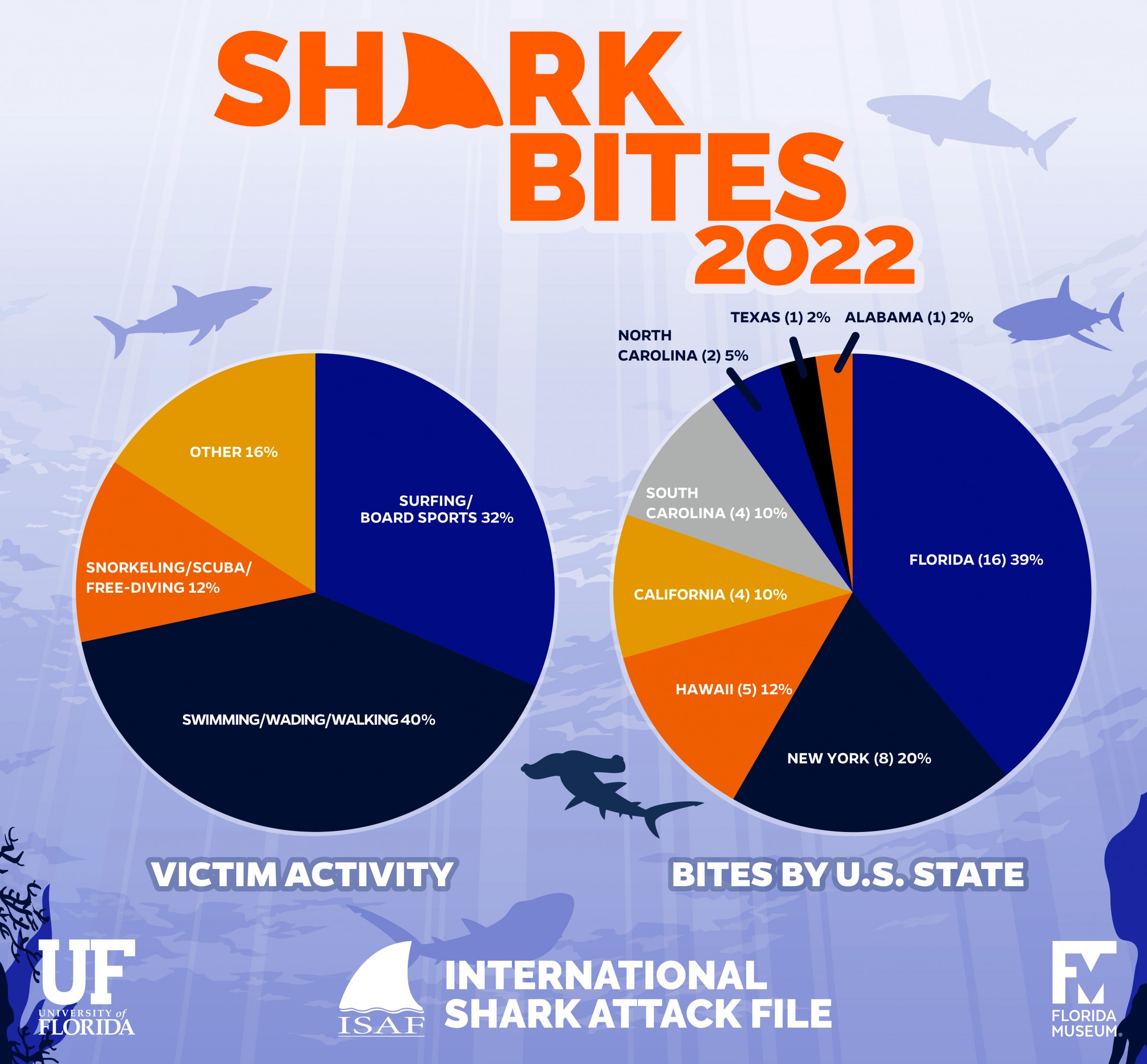The number of unprovoked shark attacks worldwide decreased last year, tying with 2020 for the fewest number of reported incidents in the last 10 years. According to the University of Florida’s International Shark Attack File, there were a total of 57 unprovoked bites in 2022, most of which occurred in the United States and Australia. Of these, five attacks were fatal, down from nine deaths in 2021 and 10 the year prior.
Since 2013, there has been an average of 74 unprovoked bites per year. 2020 was a notable exception, when COVID-19 related travel restrictions and beach closures likely resulted in fewer encounters between humans and sharks. The overall reduction in the number of bites last year may reflect the documented global decline of shark populations.
“Generally speaking, the number of sharks in the world’s oceans has decreased, which may have contributed to recent lulls” said Gavin Naylor, director of the Florida Museum of Natural History’s Florida Program for Shark Research. “It’s likely that fatalities are down because some areas have recently implemented rigorous beach safety protocols, especially in Australia.”
The International Shark Attack File places a strong emphasis on unprovoked bites in its annual report and does not highlight attacks that may have been prompted by mitigating circumstances, such as fishing lines cast in the direct vicinity of the incident or the presence of chum in the water. There were 32 additional bites in 2022 that fit the ISAF’s criteria for having been intentionally or unintentionally provoked.
“Unprovoked bites give us significantly more insight into the biology and behavior of sharks,” Naylor said. “Changing the environment such that sharks are drawn to the area in search of their natural food source might prompt them to bite humans when they otherwise wouldn’t.”
Global numbers at a glance

Image by Jane Dominguez/University of Florida
As in previous years, the U.S. had the highest number of bites, and Florida again had more reported bites than anywhere else on Earth. None of Florida’s 16 unprovoked bites were fatal, but two — likely from bull sharks (Carcharhinus leucas) — required medical treatment resulting in amputations. A woman snorkeling in the Dry Tortugas early in the year was notably bitten by a lemon shark (Negaprion brevirostris), which rarely attack humans. The incident marked only the 11th known unprovoked attack from this species.
The U.S. had only a single unprovoked fatality, which occurred late in the year when a snorkeler went missing along Keawakapu Beach in Maui, Hawaii.
Australia had nine confirmed unprovoked bites, and single bites occurred in New Zealand, Thailand and Brazil. Two fatal attacks occurred on the same day in Egypt’s Red Sea, where shark encounters are considered rare. South Africa, which averages a few bites a year, had two unprovoked attacks in 2022, both of which were fatal and likely caused by white sharks.
Long Island experienced record number of shark bites

Image by Jane Dominguez/University of Florida
Although there were fewer bites last year, a spike in localized incidents has prompted concern from residents and government officials in some areas. New York had a record eight bites in 2022, six of which have been confirmed. Before these attacks, the state had only 12 reported unprovoked bites.
In 2016, researchers determined that juvenile sand tiger sharks (Carcharias taurus) had taken up residence in Great South Bay, between Long Island and Fire Island. Young sharks are vulnerable to predation from larger individuals and species, and sheltered bays can provide them with a measure of protection.
According to Naylor, the majority of bites in Long Island last year were likely from sand tiger sharks that were drawn into the surf zone by an influx of baitfish.
“The Gulf Stream’s eddies ebb and flow each year. Sometimes they can come very close to shore, bringing nutrients and fish with them. The juvenile sand tigers will follow the fish, which in some cases leads to an uptick in encounters with people,” he said. “But local perceptions of shark bites rarely map to global statistics. If you zoom out, these eddies unpredictably break off from oceanic currents all over the world in haphazard ways.”
For as long as records have been kept, there have been no reported fatalities from sand tiger attacks, but juveniles have often been implicated in non-lethal bites.
“Juveniles tend to be more experimental and will try things that an adult shark wouldn’t,” Naylor said. “If fish are especially dense where people are swimming and visibility is poor, then it is more likely that young sharks, which lack the experience of older animals, will mistake a swimmer’s foot for their intended prey.”
Red Sea attacks make headlines

Image by Jane Dominguez/University of Florida
Two attacks that occurred less than a mile from each other in the Red Sea off Egypt’s coast were both fatal. The attacks may have been perpetrated by a single shark — initially misidentified as a mako (Isurus oxyrinchus) — but it’s currently unclear which species was responsible. The shape and coloration of the fins indicate it may have been a tiger shark (Galeocerdo cuvier).
Shark attacks are relatively rare in the Red Sea, but when they do occur, they’re often fatal, Naylor said. This is due primarily to the unique topography of the region. The Red Sea began forming roughly 50 million years ago as the tectonic plates underlying Africa and Arabia began pulling apart, creating a steep gouge between them.
“It’s a very unusual marine system because the seafloor drops so precipitously, as much as 1,000 feet in 100 yards in some places,” Naylor said.
In regions like eastern North America, where the continental shelf slopes gradually, large pelagic sharks often keep a wide berth of the coast. In the Red Sea, they’re mere meters from the shore, Naylor explained.
“Open oceans are often pretty bleak, and the pelagic sharks that live in them make their living by opportunism. Whatever potential food source they find, they’ll sample.”
Reducing your risk
The chances of being bitten by a shark remain incredibly low. According to the World Health Organization, drowning is the third leading cause of accidental death worldwide, and coastal features like rip tides and strong currents pose a greater risk to beachgoers than sharks.
The International Shark Attack File provides a curated list of recommendations for further reducing your risk of a shark bite, such as removing reflective jewelry before entering the water and avoiding areas where people are fishing. For more resources, including the full 2022 report, you can visit the International Shark Attack File’s website. The full infographic with summary statistics and safety tips is also available for download.
Source: Gavin Naylor, gnaylor@flmnh.ufl.edu, 352-273-1954
Media contact: Jerald Pinson, jpinson@flmnh.ufl.edu, 352-294-0452